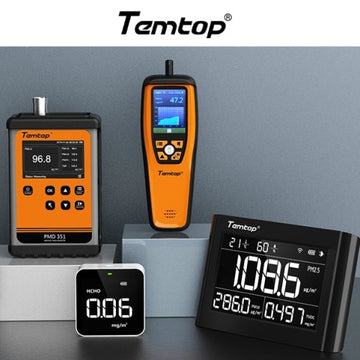Air Quality Insights (Part II): CO₂ and Temperature-Humidity — The Hidden Drivers of Comfort, Health, and Productivity
When people talk about “air quality,” they often think of pollutants like PM2.5 or formaldehyde. Yet carbon dioxide (CO₂) and temperature-humidity balance are equally vital. They are not toxic in the traditional sense, but they act as environmental indicators—signaling whether a space is well-ventilated, healthy, and cognitively supportive.
CO₂: A Ventilation Signal and a Cognitive Efficiency Marker
Where does CO₂ come from?
Indoor CO₂ mainly comes from human exhalation, and secondarily from combustion (cooking, heating, infiltration from traffic). Elevated CO₂ levels usually mean insufficient ventilation. This also implies the potential accumulation of other indoor pollutants (volatile organics, bioaerosols).
What does science say?
A Harvard study (Allen et al., 2016, EHP) showed that when indoor CO₂ rose from ~600 ppm to 945 ppm, cognitive test scores dropped by ~15%. At ~1400 ppm, they dropped by nearly 50%. This is not direct poisoning, but reduced performance in higher-order decision-making and information use.
Systematic reviews (Satish et al.; Wolkoff, 2021, IJHEH) confirm that even “ordinary indoor CO₂” can impair performance, especially under poor ventilation.
Real-world example:
In a tech company’s small meeting room, CO₂ often climbed above 1600 ppm within an hour, leaving attendees dizzy and unfocused. After adopting a rule of opening windows 10 minutes before meetings and again mid-session, CO₂ stayed below 1000 ppm, and participants reported improved clarity and engagement.
Practical recommendations:
● Use NDIR-based CO₂ sensors and place them at breathing height.
● Treat CO₂ as a ventilation signal, not an absolute “air quality pass/fail” line (ASHRAE, 2025).
● Aim for <1000 ppm in offices and classrooms; open windows or activate mechanical ventilation when thresholds are crossed.
Temperature and Humidity: More Than Comfort
Temperature:
Thermal stress shapes concentration. Research shows productivity peaks around 21–22°C; at 30°C, output can fall by ~8.9% (Seppänen et al., 2006, Indoor Air). Overheating increases fatigue, while cold suppresses circulation and immune resilience.
Humidity:
Relative humidity (RH) affects both human physiology and pollutant behavior.
● Too low (<30%): dry mucosa, higher infection risk, increased discomfort.
● Too high (>60–70%): mold, mites, and faster emissions of chemicals like formaldehyde.
Studies (Jones et al., IJERPH; Wolkoff, 2021) converge on 40–60% RH as the sweet spot—balancing comfort, health, and productivity.
Practical Guidelines by Scenario
● Homes & Bedrooms: Target 600–900 ppm CO₂, 20–25°C, 40–60% RH. Pre-ventilate before sleep; use humidifiers or dehumidifiers seasonally.
● Offices & Meeting Rooms: Keep CO₂ <1000 ppm, 21–24°C, 40–60% RH. Schedule ventilation breaks during meetings, install visible CO₂ displays to nudge behavior.
● Classrooms: Aim for <1000–1200 ppm CO₂, 22–24°C, 40–60% RH. Ventilate between classes, match fresh air supply to occupancy.

Common Misconceptions
● Myth 1: “CO₂ >1000 ppm means air is unsafe.”
● Reality: CO₂ is a ventilation signal, not an absolute health threshold (ASHRAE, 2025).
● Myth 2: “Air conditioning = fresh air.”
● Reality: Most AC units only recirculate indoor air. Without outdoor air exchange, CO₂ and pollutants accumulate.
● Myth 3: “Higher humidity = healthier air.”
Reality: Above 60–70% RH, risks from mold, mites, and chemical emissions outweigh benefits. Takeaway:
Takeaway:
CO₂, temperature, and humidity are not just numbers on a display—they shape how you feel, think, and perform. By treating them as interconnected levers and managing them with smart monitoring and ventilation, we can turn “feeling fresher, thinking clearer, working better” into an everyday standard.
References:
● Allen, J.G. et al. (2016). EHP – Cognitive scores declined with CO₂ rises.
● ASHRAE (2025). Indoor Carbon Dioxide — Ventilation and IAQ – CO₂ as a proxy, not a limit.
● Seppänen, O. et al. (2006). Indoor Air – Productivity peaks at 21–22°C.
Room temperature and productivity in office work | Indoor Environment
● Wolkoff, P. (2021). IJHEH – Optimal 22–24°C & 40–60% RH zone.
● Jones, E.R. et al. (2021). IJERPH – Low/high RH linked to respiratory issues.
INDOOR HUMIDITY LEVELS AND ASSOCIATIONS WITH REPORTED SYMPTOMS IN OFFICE BUILDINGS - PMC
● Wolkoff, P. (2021). IJHEH – Optimal 22–24°C & 40–60% RH zone.Health, work performance, and risk of infection in office-like environments: The role of indoor temperature, air humidity, and ventilation - ScienceDirect
● Jones, E.R. et al. (2021). IJERPH – Low/high RH linked to respiratory issues.
INDOOR HUMIDITY LEVELS AND ASSOCIATIONS WITH REPORTED SYMPTOMS IN OFFICE BUILDINGS - PMC

























